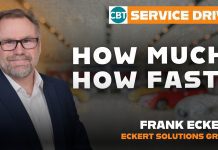The effect of the novel coronavirus has yet to recede in the United States, and the overall consumer sentiment among Americans is split between anxious and confident. In addition to fear over job security, anxiety regarding personal and family health stay steady. For car owners whose vehicles require maintenance or repairs, this week’s Deloitte State of the Consumer Tracker survey shows an increasing trend in postponing a visit to the dealership.
It’s too early to say how many of those postponed services are related to health concerns specifically, although it can be safely inferred that it’s a substantial portion. Alleviating the fear of exposure to COVID-19 is possible with vehicle pickup and drop-off for service appointments.
Budding Concept Forced into Action
In recent years, vehicle drop-off and pickup was promoted for convenience, much like the ease-of-use Amazon provides. Helping dealers eliminate the interruption to a car owner’s day was the intent, increasing the potential for customer loyalty.
Adoption took on a different form this year. Valet services were implemented to quell a customer’s fears of coming into contact with the virus and to encourage social distancing. It also aided customers in complying with shelter-at-home orders while still getting necessary vehicle servicing and repairs completed.
Challenges Dealers Face
However, vehicle valet for the service department comes with heightened costs. For dealerships where the process is brand new, staffing and scheduling are the main concerns.
Service valets and lot attendants can be used for the occasional vehicle pickup and delivery, but it takes them away from important duties in-store. Either additional staff are necessary to implement vehicle delivery options or a third-party partner is required. Since most requests are for early morning and late afternoon, a midday lull where those employees must stay available also means they’re unproductive.
As well, scheduling deliveries and pickups poses a challenge. Dealers can often expect multiple requests that overlap. Thus, it’s more than just drivers that are required – a central coordinator is necessary too.
Ways to Implement Vehicle Pickup and Drop-off
Just like customers are more likely to buy a car where steps in the process is available online, it’s expected that service customers are more likely to service their vehicle where it can be done without having to visit in person. Like digital retailing, vehicle pickup and drop-off isn’t going away – it’s only going to become more important.
Dealers have options to implement the offering in their service departments.
An In-House Team
For some large dealers and dealer groups, it makes sense to hire a team. This group of employees would include a coordinator and drivers, the number of which would be based on demand. Ideally, the same team would participate in remote sales deliveries in cooperation with the sales team. Staffing costs could need to be closely monitored.
Ride Hailing Services
Where it doesn’t make sense to have a dedicated team in-house, ride-hailing services like Uber and Lyft can fill the gap. Someone on the dealer staff would still need to pick up and drop off the vehicle, but a chase driver isn’t necessary. This can be easier on staffing costs but transportation costs are unpredictable, as is scheduling.
Third-Party Services
Services like RedCap specialize in improving convenience for service and sales departments. They can integrate to assist with customer shuttling, vehicle pickup and drop-off, and remote selling not to mention remote RO write-up. While it comes at a cost, a third-party ensures scalability for your dealership and can be kept accountable.
Did you enjoy this article from Jason Unrau? Read other articles from him here.


While you’re here, don’t forget to subscribe to our email newsletter for all the latest auto industry news from CBT News.








